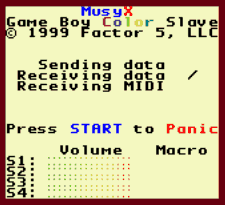The following text is copied from: http://www.factor5.de/licensing_gameboy_musyx.shtml
Since the Game Boy hardware is already ten years old, it can be considered rather old fashioned by today's standards. Nevertheless it is possible to create surprisingly good sounds if the sound artist is fully aware of the possibilities and the limitations of the Game Boy sound hardware.
The Game Boy sound hardware is comprised of 4 individual sound generators of three different kinds. Two of those four generators are identical in function with the exception of one special feature on one of them.
The three different kind of sound generators are as follows:
Voice1 and Voice2 use rectangular wave patterns to create a sound
Voice3 uses a 32 4-bit sample long wave pattern to create sound
Voice4 creates random noise
Voice1 also offers a very limited pitchsweep function, which is NOT supported by MusyX. Instead we are offering 2 sophisticated pitchsweeps for Voice1 through Voice 3 and a more flexible envelope for all 4 voices in software.
Finally, each voice can be assigned to the left, right or both sound outputs individually. This selection allows for a wide stereo spectrum.
MusyX even extends on the capabilities of the Game Boy and adds a few new features like extended sample playback and pulse-width modulation.
Extended features fall in the categories of pitch and volume changes. To modify pitch for instance, MusyX adds features like vibrato, portamento, pitch sweeps, fixed pitches and random pitches for Voice1, Voice2 and Voice3.
Enhancements for volume controls are ADSR curves, envelopes, fade-ins and fixed volumes for all 4 voices.
New features are:
Velocity dependent selection of the rectangular wave pattern for Voice1 and Voice2
Pulse-width modulation of a rectangular wave pattern for Voice3
Velocity dependent creation of a rectangular wave pattern for Voice3
Playback of samples in two quality settings (normal and low) for Voice3 as music instruments or sound effects
Playback of samples in high quality using full CPU performance for introductory voice or music.
In addition, the SMaL programming language offers control of the sound while it is playing in numerous ways with control commands like: wait, loop, goto, trap, split and more.
How do you compose on a Game Boy? With exactly the same programs and environment MusyXprovides for other platforms: A slave program running on the PC communicates with the MusyX editor and a Game Boy slave running on Game Boy Color. It also constantly receives MIDI data from a connected MIDI keyboard or the virtual MIDI keyboard in the MusyX editor.
To do this you will need to connect a standard Game Boy Color running the slave program to the PC, via a supplied customized link cable. This cable plugs into the link port of Game Boy Color and any available printer port of the PC.
The slave receives data from the MusyX editor using a network connection known as TCP/IP. This virtually enables any machine in your Local Area Network or even any machine on the globe, to serve as your sound slave. If you are planning to use the same machine to run both the slave and the editor, you still need to have TCP/IP installed and have both the editor and the slave refer to the same IP address.
To experience the possibilities of MusyX, listen to the provided examples:
Found it today while searching for something else, thought it was pretty interesting. And sorry for the cross post.
// nordloef
